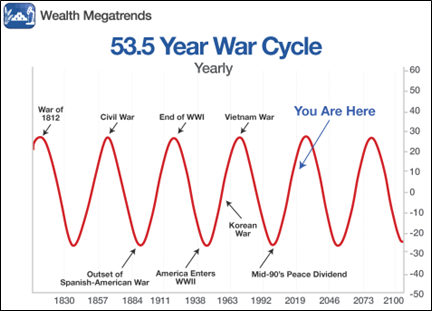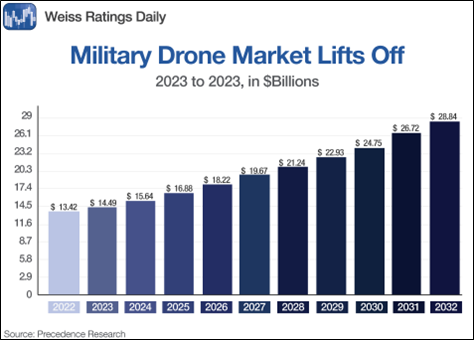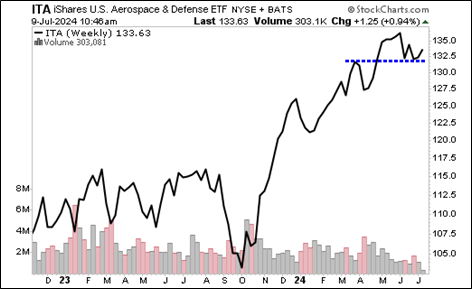A Robotic Hellscape Is Heading to the Taiwan Strait
We are seeing the future of warfare right now, and it is killer robots.
This megatrend is already starting to play out in Ukraine.
And the next robotic battlefield may take over the skies of Taiwan.
There, Pentagon planners vow to create a “hellscape” if China invades.
China has long claimed this democratic East Asian island as its own territory. And Xi Jinping has made no secret that he wants the Chinese Communist Party to take control of it by any means necessary.
The U.S. has pledged to defend Taiwan from invasion by China.
The cost of doing so, however, would be catastrophic. Ships, aircraft and more would get mobilized. And sailors, soldiers and civilians would suddenly find themselves in harm’s way.
Does this have to happen? No. But per the war cycle — something I’ve talked about many times — it’s likely to happen.
In the last century, a few mathematicians, cultural anthropologists and sociologists have noticed something:
There is a regular pattern to the outbreak of war.
The social and economic patterns that make war likely are almost as predictable as the sun's movement across the sky or the changing of the seasons.
It wraps up in a 53.5-year cycle.

And right now, this big war cycle is converging with other cycles to bring the world to a flashpoint.
You’re seeing these sparks fly in Ukraine. And that’s where robots are changing the battlefield. Drones in the air and sea allow Ukraine to go toe-to-toe with Russia.
There are many reasons that Russia hasn’t succeeded in its conquest of Ukraine, and drones are one of them.
Drone & Counter-Drone
Now, the Russians aren’t sitting on their hands. They have their own drones and counter-drone technology.
They’ve become very good at jamming Ukraine’s drone signals. As a result, Ukraine loses about 10,000 drones a month, according to the Royal United Services Institute.
The easiest way to take out a drone is to jam its connection with the human controlling it.
That’s where AI comes in. When drones can think for themselves, they’re VERY hard to stop.
AI makes aircraft drones — as well as robot submarines and tanks — terrifyingly more effective. And there is no Geneva Convention to prohibit this smarter, potentially much more lethal tech.
Military drone sales are already rising at a compound annual growth rate of nearly 8%. Here’s a recent forecast …

I believe this is just the start. And what the Pentagon is planning in the Taiwan Strait offers more proof.
“I want to turn the Taiwan Strait into an unmanned hellscape,” Admiral Samuel Paparo, U.S. commander in the Indo-Pacific region, told Bloomberg.
The Pentagon’s project to defend Taiwan is called “Replicator.” The plan is to turn out cheap “all-domain attritable autonomous systems,” or ADA2, to flood the skies and waters around Taiwan. Attritable means “able to undergo attrition” — or nearly expendable.
Humans would make the decision to launch swarms of kamikaze drones. Not just flying drones but also in the sea, as either mines or torpedoes.
The Pentagon says this robotic hellscape could de-escalate any conflict in Taiwan because it would save on mass casualties.
I find that a bit of wishful thinking. Sort of like in the late 1800s, when generals thought the invention of the machine gun would make wars too terrible to fight.
Supply Problems
Taiwan and the Pentagon need many reliable, cheap drones.
Unfortunately, the U.S. doesn’t make those. Ours tend to be touchy and expensive.
U.S. drones had such a high failure rate in Ukraine that the country’s military turned to off-the-shelf drones from Chinese drone giant Da Jiang Innovations.
However, if Taiwan uses those same drones, there is a good chance China knows how to turn those drones off remotely.
So, what to do now? Well, failure can be a learning experience.
U.S. drone makers are using the lessons learned in Ukraine to build better machines. Adding AI will make them even more useful.
And so, the drone arms race is on.
The U.S. is already building some “wow” weapons: AI-equipped killer robots that could reshape warfare.
These include the Manta Ray unmanned underwater vehicle from Northrop Grumman (NOC), the XQ-58 Valkyrie unmanned aerial combat vehicle from Kratos Defense (KTOS) and the Boeing (BA) MQ-28 Ghost Bat.
These aren’t cheap, though they are much less costly than the manned equivalent.
The submarines, in particular, can go for longer and deeper than manned submarines. And they have the potential to be highly deadly.
Now, combine this new tech with that war cycle I showed you. I think there will be some fireworks not only on the battlefield but also in select defense stocks.
This group is in a very virtuous cycle and could reward investors going forward.
You can play this through individual stocks. But as Boeing shows, sometimes you can have a quasi-government monopoly and still see the doors fall off your business. So, be careful.
You can also buy an exchange-traded fund. One of the better ETFs is the iShares U.S. Aerospace & Defense ETF (ITA).
It has a dividend yield of 0.93% and a total expense ratio of 0.4%. Here’s a weekly chart …

Looking at the chart, you can see that ITA broke out, then came back and tested that former overhead resistance as support. It seems to be bouncing now.
This is a lower-risk entry point.
The fund holds Boeing, sure, but also plenty of other stronger names including RTX (RTX), Lockheed Martin (LMT), General Dynamics (GD) and Northrop Grumman.
Whether you pick up shares of ITA or not, the war cycle is building steam.
If you think there are a lot of conflicts raging around the world, you ain’t seen nothin’ yet.
Intelligent investors will protect themselves — and potentially profit.
All the best,
Sean
